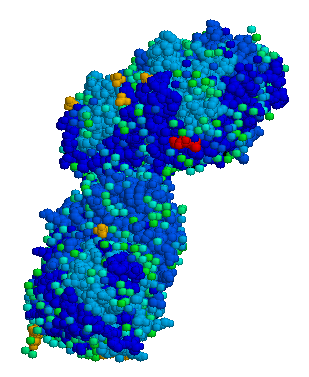Gaucher Disease
Gaucher disease (pronounced "Go-shay") is the most common of the lipid storage diseases. It is caused by a deficiency of the enzyme glucocerebrosidase, leading to an accumulation of its substrate, the fatty substance glucocerebroside. Fatty material can collect in the spleen, liver, kidneys, lungs, brain and bone marrow. Symptoms may include enlarged spleen and liver, liver malfunction, skeletal disorders and bone lesions that may cause pain, severe neurologic complications, swelling of lymph nodes and (occasionally) adjacent joints, distended abdomen, a brownish tint to the skin, anemia, low blood platelets and yellow spots in the eyes. Persons affected most seriously may also be more susceptible to infection. more...
The disease affects males and females equally. It is the most common lysosomal storage disease. It is named after the French doctor who originally described it in 1882.
Subtypes
Gaucher disease has three common clinical subtypes. Type 1 (or nonneuropathic type) is the most common form of the disease. It occurs most often among persons of Ashkenazi Jewish heritage. Symptoms may begin early in life or in adulthood and include enlarged liver and grossly enlarged spleen, which can rupture and cause additional complications. Skeletal weakness and bone disease may be extensive. The brain is not affected, but there may be lung and, rarely, kidney impairment. Patients in this group usually bruise easily and experience fatigue due to low blood platelets. Depending on disease onset and severity, type 1 patients may live well into adulthood. Many patients have a mild form of the disease or may not show any symptoms. Type 2 (or acute infantile neuropathic Gaucher disease) typically begins within 3 months of birth. Symptoms include an enlarged liver and spleen, extensive and progressive brain damage, eye movement disorders, spasticity, seizures, limb rigidity, and a poor ability to suck and swallow. Affected children usually die by age 2. Type 3 (the chronic neuronopathic form) can begin at any time in childhood or even in adulthood. It is characterized by slowly progressive but milder neurologic symptoms compared to the acute or type 2 version. Major symptoms include an enlarged spleen and/or liver, seizures, poor coordination, skeletal irregularities, eye movement disorders, blood disorders including anemia and respiratory problems. Patients often live to their early teen years and often into adulthood.
Signs and symptoms
- Painless hepatomegaly and splenomegaly; the spleen can be 1500-3000 ml, as opposed to the normal size of 50-200 ml.
- Hypersplenism: increased destruction of red and white blood cells and platelets, leading to anemia, neutropenia and thrombopenia (with an increased risk of infection and bleeding)
- Cirrhosis of the liver is rare
- Neurological symptoms occur only in some types of Gaucher's (see below):
- Type II: serious convulsions, hypertonia, mental retardation, apnea.
- Type III: myoclonus, convulsions, dementia, ocular muscle apraxia.
- Osteoporosis: 75% develop visible bony abnormalities due to the accumulated glucosylceramide. Erlenmeyer flask deformity of the distal femur.
- Yellowish-brown skin pigmentation
- No cardiac, renal and pulmonary signs
Diagnosis
In populations with high rates of carriage (Ashkenazi Jews and Norrbottnian Swedes), some family members of the index patient may already have been diagnosed with Gaucher's. Truly sporadic cases may suffer diagnostic delay due to the protean symptoms.
Read more at Wikipedia.org



